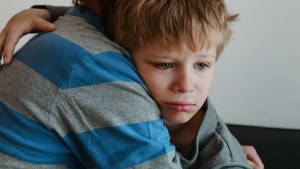Lenten Campaign 2025
This content is free of charge, as are all our articles.
Support us with a donation that is tax-deductible and enable us to continue to reach millions of readers.
The latest school shooting in Uvalde, Texas has left the world reeling, and parents no doubt holding on to their children that little bit tighter.
As we’re reminded that the world is not as safe as we’d like it to be, we question what can be done from a practical point of view, but also how we can protect our children’s mental health as they cope with these frightening events.
After all, after this deadly shooting, the active shooter drills will no doubt increase, and our kids will be made even more aware that going to school is potentially dangerous — even deadly. It’s not exactly the education that parents want their children to receive.
Sadly, my own son went through a traumatic experience at school just after the spate of terrorist attacks in Paris, France. Schools were on high alert to expect attacks and drills became the norm.
Unfortunately, on one particular day, someone inadvertently set off the alarm. None of the teachers were aware that it was an accident, and terror set in. Everybody believed there was a terrorist in the school.
My then-8-year-old son’s teacher became hysterical and was crawling on the floor in tears. My child, who already suffered from intense anxiety, was in the school cafeteria. He ran into the kitchen and found himself a place to hide in a metal cupboard under a stove.
Thankfully, after a number of minutes — which felt like a lifetime to him — the alarm was switched off and the principal went around the school to reassure everybody. Yet those 10 minutes or so left my son too traumatized to return to school. He had recurring nightmares that left him waking up in a blind panic. This went on for over a year.
I know that many other parents find these active shooter drills potentially dangerous to their children’s mental health. And it makes sense; it doesn’t take much to understand there’s no way of sugar-coating these drills. So I can only offer the advice given to my family by my son’s psychologist and educators.
Acknowledge the fear
While parents can have a tendency to try and brush off their child’s fears, it’s very important for them to be able to have their justifiable anxieties acknowledged. While you can listen to your child, you can also help them to share their feelings.
There are a number of ways my son expressed himself, and his fears, when he didn’t quite have the words. For example, he reenacted the situation using his Playmobil school, police, hospital, and fire and rescue set (this could also work with drawing or using LEGO).
He played out exactly what happened at school, and when I played with him I showed him what would have happened had there really been a shooter. I emphasized the role of “the helpers,” from the police coming to his rescue to the skilled doctors in his Playmobil hospital fixing any injuries. By trying to reassure him that he would not be alone, that there would be people to help, it assuaged some of his fears.
Due to the level of his anxiety, he also did sessions of psychodrama, a type of experiential, action-based therapy in which people explore issues by acting out events from their past. Because he was able to control the actors with his imagination, and therefore the outcome, he was able to cope better with real life drills. (Interestingly, over time, he stopped acting out shooter drills and moved on to winning world champion soccer matches!)
Be prepared
I had awarned my son that there would be possible drills at school and not to be worried. However, this wasn’t enough. Due to the severity of his anxiety, his psychologist told me that the school needed to prepare us in advance of these drills. So if they were going to practice on that particular day, his teacher would inform him and tell him to be prepared.
You might think this negated the effectiveness of the drill. However, when you have a child who is absolutely petrified of this type of scenario, it doesn’t change much in terms of carrying out the safety measures effectively. As my son told me, “I don’t even breathe when I’m under my desk.” Yet, it allows him to feel a little more in control.
And that’s the problem for many kids today. If they are particularly anxious they need to feel some level of control. So these surprise drills leave particularly anxious children in a traumatic state.
Even a few years later, and more drills under his belt, my son still reports having “soaking wet hands” if he has to practice the drills. He still has a migraine in the evening of a drill. But, thanks to the heads up from his teacher, he manages to get through the experience with a little less fear.
And pray
My son sees me pray every night. I always ask for God to watch over and protect my children. This allows my son to feel he can ask the same. It gives him (and me) a sense of reassurance, and it certainly helps him get a better night’s sleep.
If your child is particularly traumatized I would certainly recommend getting help from a medical professional or therapist, and informing your child’s school. Each child is different, with his or her own sensitivities, and it’s important that they get the right help.



